The End of Caruso’s Miramar?
Planning Commission Sends Project Back to the Drawing Board

“Okay, let’s go have a cocktail.”
That’s what a frustrated Rick Caruso exclaimed after talking to media and supporters -some of whom were in tears – following another marathon session for his Miramar project in front of the Montecito Planning Commission (MPC). His words echoed the sentiment of most who spent 12 hours in the stuffy and hot County Planning Commission board room Wednesday. But Caruso probably needs that drink more than most, as his project was essentially shut down by the commission.
And rather than go back to the drawing board to initiate all the changes requested and recommended by the board, Caruso indicated he will more than likely sell the land he bought just 19 months ago – a move that would mean three owners in 10 years have been unable to revive the historic Miramar Hotel. Caruso said that after the night’s events, there was only a “very small chance” he was going to stick around to develop the project. “You’ve got me stuck,” he told the MPC boardmembers after they decided a denial of the project would be inappropriate and that they would continue the project to a future date. “I have my own financial concerns. Let someone else figure something else out for the property.”
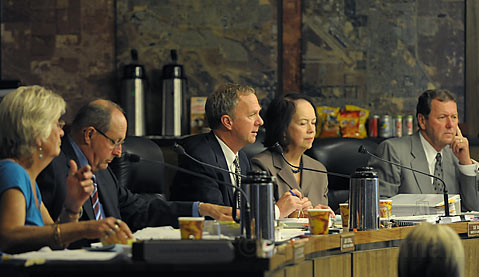
While there is evidence suggesting county staff has been pressed to expedite this project, no one can accuse the MPC of hustling with it. Their July 16 meeting lasted ten-and-a-half hours, and today’s meeting lasted from 9 a.m. to 9 p.m., including a 45-minute lunch break. This meeting lacked the glitz and glam and promotional movies, buttons, breakfast, and lunch that Caruso brought with him last time, but the drama from behind the dais this time provided the entertainment.
After coming up with a list of roughly a dozen changes the board agreed Caruso implement into his plan before he could go forward with his vision of the Miramar, the commission moved on to CEQA (California Environmental Quality Act) issues-the meat of the opposition to the project. While discussion centered on whether an addendum should be made in the areas of traffic and parking, the biggest issue for the board was water supply. They indicated – in a 4-1 vote with chair Bob Bierig dissenting – they’d like to see a SEIR (Supplemental Environmental Impact Report) done on the issue, which Caruso argued had already been solved by the Montecito Water District (MWD) earlier in the day. In fact, MWD director Tom Mosby had told the commission that Caruso’s project would receive 45 acre-feet per year, and anything used above that number would be charged at a higher rate. County Counsel Mike Ghizzoni suggested an SEIR would give the county better legal standing should the county be sued.
There also was discussion about whether the current infrastructure could handle the Fire District’s needs should there be a fire on the property. But there are five existing fire hydrants in and around the property, pointed out project manager Matt Middlebrook, who also said, along with Mosby, that testing had been done to ensure there was enough water pressure for firefighting. While 1,500 gallons per minute are needed to fight a fire, the hydrants tested produced between 1,500 and 3,000 gallons of water every minute, far more than enough, Middlebrook said.
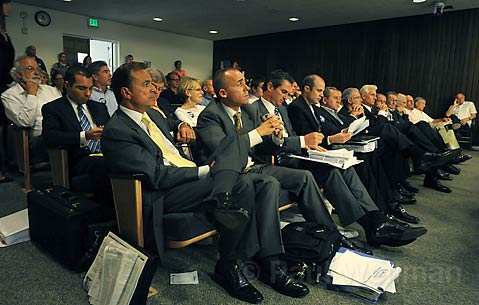
Caruso, who made several changes between the two MPC hearing dates, was planning a 204-room hotel with restaurants fit for 258 seats and a beach and tennis club with 300 members. Among the changes was the elimination of the second floor of the spa room. Caruso indicated the height of the building will be reduced by 11 feet, reducing the mass of the building as seen from South Jameson Lane. But, at the end of the day, his changes weren’t enough. “I feel pretty strongly about this,” Commissioner Michael Phillips said. “This project is more Monticello than Montecito. I think it needs to look smaller somehow. I’d like to see something else.”
Despite indicating at the previous meeting public comment would be closed, Bierig turned on the microphone so the public could be heard, and they gave an earful. While the first meeting saw large support for Caruso’s plan, this time around the tide was tilted in favor of those opposed to Caruso’s project.
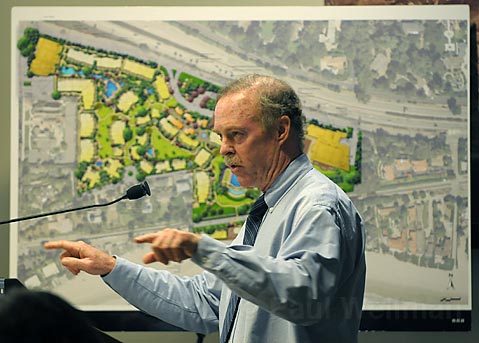
Supporters of the project were ready to have the site cleaned up and eager to visit a five-star resort fit with a ballroom to host 600-person parties, a beachside restaurant, and 204 hotel rooms. “Get it going or get on with it,” said Montecito resident Vern Langdon. Caruso expanded the size of the bedrooms to bring them up to current day plush standards, leading to a larger square footage, but not a higher intensity of use. In fact, he argued, the number of rooms in his plans is actually fewer than that in Ian Schrager’s, the boutique hotelier from whom Caruso bought the property. One proponent told the commission the county could expect more than $3 million in real estate tax each year, along with a couple hundred thousand in sales tax and more than $1 million in hotel bed taxes if it was built. “It’s a beautiful project and an economic benefit to all of us,” said Montecito resident Richard Eiler.
Critics have likened the size of the main building, which had a height of 49 feet – 11 feet above the maximum allowed by the Montecito Community Plan – to that of the Goleta Home Depot store. But supporters said opponents were nit-picky and didn’t want anything built on the property. “They don’t know their mass from a hole in the ground,” said Miramar supporter Bob Hazard. Afterward, many were saying the commission was unfair to Caruso.
Here are some of the issues the Commission wanted to see resolved, which Caruso said made his project impossible:
1. Forego including the railroad parcel running through the property in the property’s floor area ratio, a computation used to keep project sizes down. “I’m trying to get the mass, bulk, and scale down,” Commissioner Claire Gottsdanker explained in her motion. Not including that parcel would’ve taken the plan out of compliance with the Montecito Community Plan, which dictates building procedure in the residential village.
2. Eliminate all two-story buildings sited in the setbacks along South Jameson. “I cannot find justification for them being in the setbacks,” Commissioner Jack Overall said.
3. Reduce the height of the main building – set at 49 feet – so it fit with the Montecito Community Plan, which has a height limit of 38 feet.
4. Build a sidewalk in between proposed diagonal parking and the Miramar wall along Jameson, to increase safety of pedestrians. Caruso had earlier agreed to this.
5. Eliminate the use of lights at the tennis courts. Caruso had earlier agreed to shut them off an hour earlier, at 9 p.m., apparently not sufficient for the commission majority.
Observers anticipated that whatever decision was made by the MPC Wednesday, it would be appealed by the losing side. But because the commission didn’t approve or deny the project and instead chose to continue the project to August 28, an appeal of the commission’s decision to the Board of Supervisor by Caruso isn’t even possible. Both sides were anticipating an inevitable lawsuit contesting whatever decision the supervisors would have made. Opponents have plenty of money to pay lawyer’s fees and nobody can question that Caruso has deep pockets.
Caruso – a heavy hitter in conservative California politics who in recent weeks held a birthday fundraiser for Gov. Arnold Schwarzenegger and who last year held a fundraiser that netted $1 million for former presidential candidate Mitt Romney – is said to be seriously considering a run at mayor of Los Angeles. Some of Caruso’s grandest projects fall within, or not far from, L.A. city limits, including the Grove in L.A. and the Americana at Brand in Glendale.
Two projects of his, however, have run into similar problems to those opponents are complaining about here in Santa Barbara. In September 2007 a state appeals court ordered that construction be halted on the second and final phase of a large development project, saying the project’s EIR was flawed. The second phase – estimated cost $1.1 billion – would build a town center with 195,000 square feet of retail and 175 new apartments on 11 acres within a new zip code. The project, known as the Village at Playa Vista, is just south of Marina Del Rey in L.A. A board of judges found the review was “deficient in its analysis of land-use impacts, mitigation of historical archaeological resources and wastewater impacts.”
More recently, media reports indicate Caruso’s plan for a big shopping mall next to the Santa Anita racetrack has been held up by a Los Angeles judge who said the project’s EIR must be revised, finding 11 deficiencies in it. Caruso’s plans for Santa Anita appear similar to The Grove and Americana at Brand, both of which feature upscale shops and outdoor restaurants.
Montecito welcomed Caruso with open arms after failed attempts by Studio 54 founder and hotelier Ian Schrager and then Montecito resort owner Ty Warner to build the Miramar. Caruso – who bought the approved Schrager plan for the various Miramar parcels in January 2007 for more than $52 million – hugged the community right back, holding dozens of meetings, collecting historic artifacts, and promising to create a beautiful resort reminiscent of the hotel that once was. But as he progressed through the county process with Schrager’s approved project from 2000 in hand, he decided in the fall to alter the plans. Back at the starting line this time with a new project – not new enough for an EIR, he claimed – he ran into opposition from some in the community.
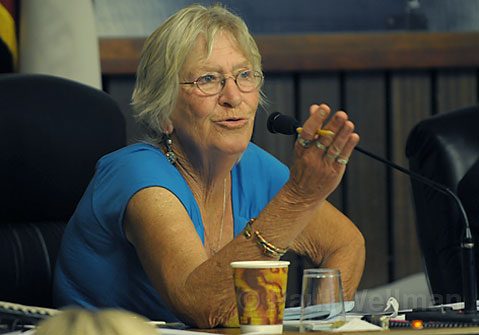
But he also received a lot of support from neighborhood groups throughout Montecito, including the Montecito Association, which has come under firefrom some of its members for not thoroughly dissecting Caruso’s plans, as the association has with other large projects in the past. Multiple commissioners hinted at the complacency of the association in their comments. “I feel you’ve been badly served by some of the community,” Bierig said. “You found a conclusion that they could accept things we could not accept.”
Caruso had indicated in the past that he wouldn’t hold onto the project should an EIR be required. In fact, with investors waiting anxiously in the wings to see their $400 million or so – Caruso hasn’t said how much the project will cost – be used, he won’t wait. And the county, expected to make more than $1 million per year in hotel tax on the site, knew it. From the get-go, county staff has been pushing the envelope with the plans. Project managers have complained of the proposed timeline being “aggressive and unrealistic” and putting “so much pressure on staff.” One county staffer, Michelle Gibbs, after asking to be taken off the project, eventually resigned.
While some residents are scared to see another developer come and go, and fear there may never be another buyer willing to come in and see the site through to completion given the stringent regulations, rumor has it that might not be the case. Big time developers Steve Wynn and Bill Marriott are both said to be interested in the property should Caruso eventually take a pass: “I was certainly enamored with this project, but if it’s not in the cards, it’s not in the cards.”
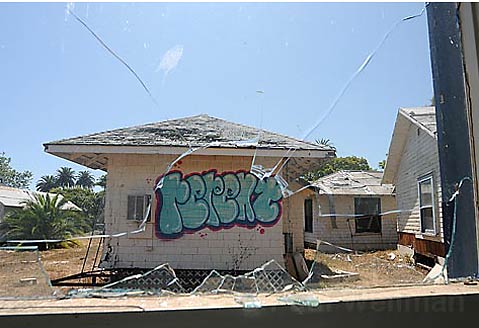
And so it remains to be seen what will come of the site peeking over fencing next to Highway 101 at 1555 South Jameson Lane, currently home to tall grass, rats, and who knows what else, all surrounding fading blue-roofed, dilapidated buildings with broken windows and peeling white paint. There’s no question in anyone’s mind the site is an eyesore, but what, or who, will relieve the pain is still yet to be revealed.



